Siege of Parachinar: A Humanitarian Crisis
Situation Report as of February 2025
Background and Timeline of the Siege
Parachinar, the capital of Kurram district in northwest Pakistan, descended into a cycle of sectarian violence and blockade in the second half of 2024. Below is a timeline of key events over approximately the last six months:
July 2024: Longstanding land disputes between local Sunni and Shia tribes erupted into clashes. Around 49 people were killed and nearly 190 injured in Kurram during July alone (HRCP calls for urgent action on Kurram crisis - HRCP). Ceasefires were attempted (one brokered in June 2023, another in October 2024), but violence repeatedly flared back up (HRCP calls for urgent action on Kurram crisis - HRCP).
August–October 2024: Sporadic fighting continued. By October, road travel to Parachinar became dangerous and was frequently halted. At least 79 people were killed in sectarian clashes between July and October, according to the Human Rights Commission of Pakistan (Kurram clashes' death toll rises to 99 after govt-brokered truce broken). The main Thall–Parachinar highway – the only land route linking Parachinar to the rest of Pakistan – was often closed due to the unrest (Parachinar Siege: 29 Children Dead As City's Only Govt Hospital Faces Shortage Of Medical Supplies - Dissent Today) (Sectarian violence in Pakistan border district claims more than 130 lives).
Late October 2024: A major outbreak of clashes in Kurram led authorities to impose road blockades and even suspend cellular services (HRCP calls for urgent action on Kurram crisis - HRCP). These measures isolated the district but failed to fully contain the violence (HRCP calls for urgent action on Kurram crisis - HRCP). Local residents began describing the situation as a “siege,” with Parachinar cut off from supplies.
November 21, 2024: The crisis escalated dramatically. Gunmen ambushed a convoy of Shia travelers in the Ochat area of Lower Kurram, killing dozens (reports range around 38–52 killed, including women, children, and security escorts) (Sectarian violence in Pakistan border district claims more than 130 lives) (Why is Parachinar Stuck in an Endless Loop of Violence? – South Asian Voices). This massacre sparked immediate retaliatory attacks: Shia tribesmen burned a Sunni village and Sunni militants struck back, turning the district into a war zone (Sectarian violence in Pakistan border district claims more than 130 lives) (Why is Parachinar Stuck in an Endless Loop of Violence? – South Asian Voices). Within a few days, more than 130 people had been killed and hundreds injured in the spiraling tit-for-tat violence (Why is Parachinar Stuck in an Endless Loop of Violence? – South Asian Voices). The violence was so intense that some 300 families fled Kurram to seek safety in neighboring areas like Hangu and Peshawar (Families flee after 32 killed in sectarian violence in Pakistan).
November 22–23, 2024: Authorities imposed a complete blockade of all roads after the November 21 ambush. The Thall–Parachinar road was shut down, effectively sealing off Parachinar (Sectarian violence in Pakistan border district claims more than 130 lives). A government committee brokered a brief ceasefire on Nov 23, allowing exchange of hostages, but clashes continued in pockets (Sectarian violence in Pakistan border district claims more than 130 lives) (Relief convoy reaches Kurram amid heavy security - Pakistan - DAWN.COM). In the 36 hours after the convoy attack, mobs attacked Baghgan (Bagan) Bazaar, burning down over 500 shops and 600 houses in revenge (Relief convoy reaches Kurram amid heavy security - Pakistan - DAWN.COM). The death toll in this late-November wave reached at least 130 (PM Shehbaz vows to maintain peace in district as 25 vehicles of second convoy reach Kurram - DAWN.COM).
December 2024: Parachinar remained under siege with the main road closed for over two months by mid-December (Parachinar Siege: 29 Children Dead As City's Only Govt Hospital Faces Shortage Of Medical Supplies - Dissent Today) (Over 100 children dead in Parachinar amid road blockades). Local tribal elders and government mediators convened a Grand Jirga (tribal assembly) to negotiate peace. Meanwhile, the humanitarian situation deteriorated (see next section). Sporadic killings continued to threaten the peace process. For example, in mid-December two Shia youth were brutally murdered by militants, stoking fear despite ongoing talks (ابنا - Photos: A sit-in protest in solidarity with oppressed Parachinar's Shia continues for seventh night in Lahore) ( Pakistanis Protest Over Parachinar Crises ).
December 31, 2024: After weeks of negotiations, a peace agreement was finally signed between the warring tribes in Kurram (Taliban, ISIS Fuelled The Sectarian Clashes in Parachinar, Says Ex-MNA - Dissent Today) ( Kurram secures peace deal: Grand jirga reaches agreement after extended deadlock ). The accord – reached via a Grand Jirga in Kohat – required both sides to surrender heavy weapons and demolish private bunkers in the area ( Kurram secures peace deal: Grand jirga reaches agreement after extended deadlock ) (Relief convoy reaches Kurram amid heavy security - Pakistan - DAWN.COM). The government pledged to reopen roads and establish a special security force to protect transport routes once peace took hold ( Kurram secures peace deal: Grand jirga reaches agreement after extended deadlock ). Despite this deal, locals remained cautious and vowed to continue protesting until roads actually reopened for safe travel (Parachinar sit-in continues despite peace deal - Pakistan - DAWN.COM).
January 2025: Implementation of the peace accord proved challenging. On January 16, a relief convoy attempting to reach Parachinar was ambushed near Baghgan, killing 2 security personnel and 8 truck drivers (Relief convoy reaches Kurram amid heavy security - Pakistan - DAWN.COM). This attack shattered the fragile calm. In response, the military launched a four-day operation (Jan 19–23) using gunship helicopters and ground forces to clear “miscreants” in parts of Lower Kurram (Relief convoy reaches Kurram amid heavy security - Pakistan - DAWN.COM) (Relief convoy reaches Kurram amid heavy security - Pakistan - DAWN.COM). They destroyed at least 8 illegal bunkers and seized caches of arms (Relief convoy reaches Kurram amid heavy security - Pakistan - DAWN.COM). By Jan 23, officials claimed the operation was successful and warned of strict action against any peace deal violators (Relief convoy reaches Kurram amid heavy security - Pakistan - DAWN.COM). Convoys resumed under heavy escort: the first relief convoy of 40+ vehicles, delayed for days by security concerns, finally reached Parachinar around Jan 20 (PM Shehbaz vows to maintain peace in district as 25 vehicles of second convoy reach Kurram - DAWN.COM). A second convoy of 45 trucks departed soon after (PM Shehbaz vows to maintain peace in district as 25 vehicles of second convoy reach Kurram - DAWN.COM) (PM Shehbaz vows to maintain peace in district as 25 vehicles of second convoy reach Kurram - DAWN.COM). These convoys brought flour, food, and medicines to the beleaguered city. Prime Minister Shehbaz Sharif announced that the situation was “returning to normal” as aid began trickling in (PM Shehbaz vows to maintain peace in district as 25 vehicles of second convoy reach Kurram - DAWN.COM), but locals remained anxious (see below).
February 2025: The siege is ongoing, albeit in a reduced form. Security forces and tribal leaders have been working to solidify the peace. By early February, 22 militant bunkers had been demolished in Kurram under the accord’s terms (Kurram residents bemoan road closures - Pakistan - DAWN.COM). Meetings between tribal representatives continued in Islamabad to discuss reopening transport routes (Kurram residents bemoan road closures - Pakistan - DAWN.COM) (Kurram residents bemoan road closures - Pakistan - DAWN.COM). Still, as of late February, the main highway has not fully reopened for civilian traffic, and Parachinar’s connectivity to the rest of Pakistan remains intermittent. The blockade has crossed five months, and residents describe only a “precarious lull” rather than a complete resolution (Another aid convoy reaches Kurram - Pakistan - DAWN.COM) (Kurram residents bemoan road closures - Pakistan - DAWN.COM).
Humanitarian Situation: Casualties, Shortages, and Displacement
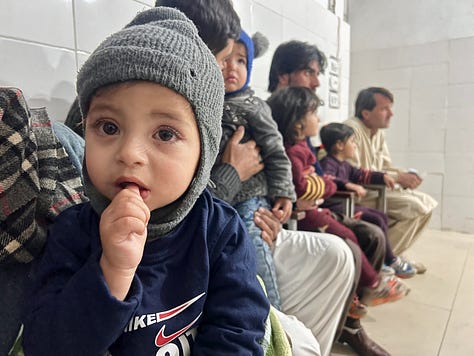
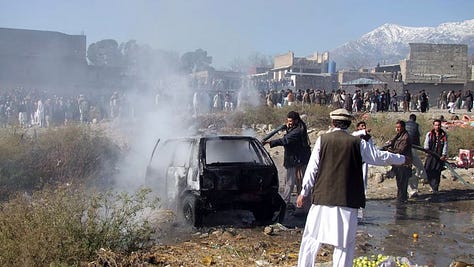
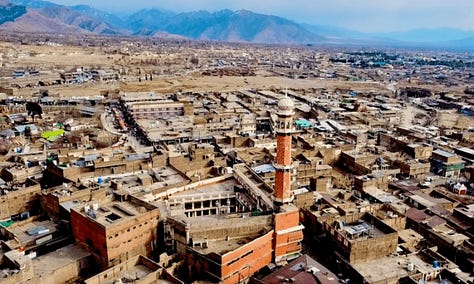
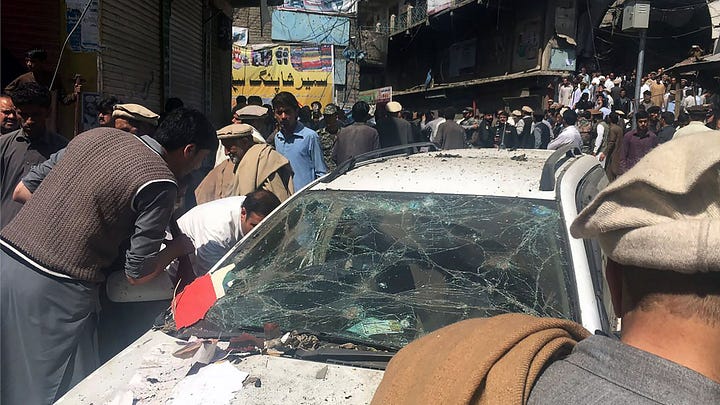
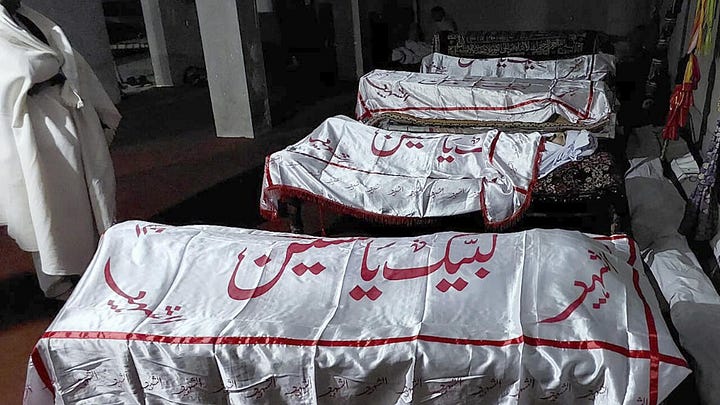
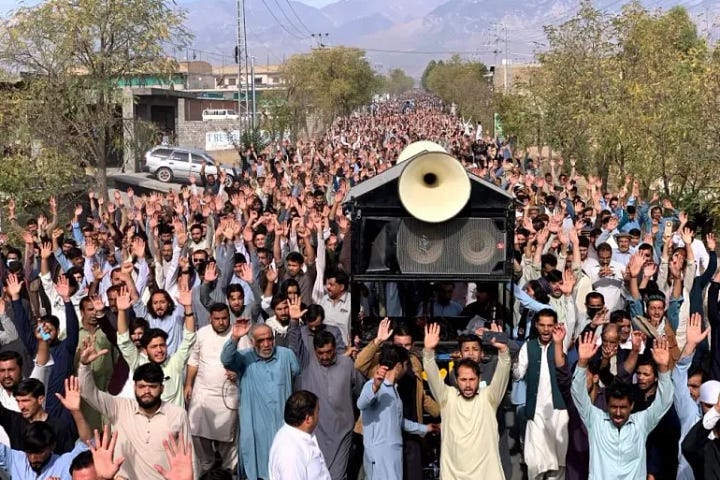
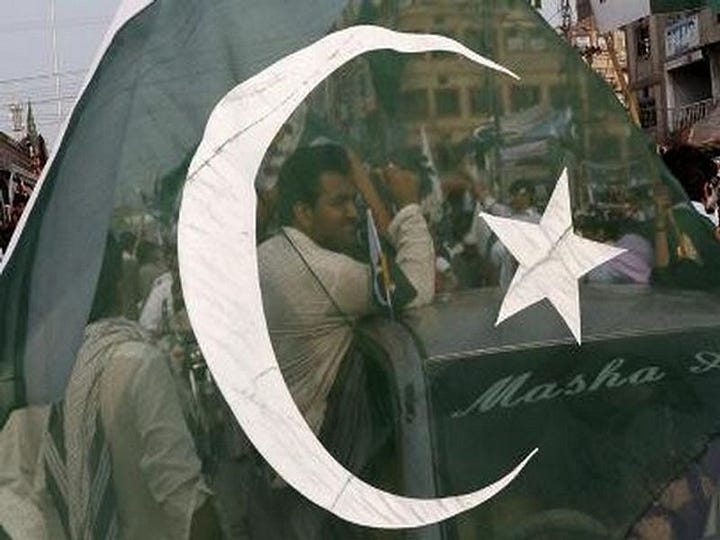
(Parachinar Siege: 29 Children Dead As City's Only Govt Hospital Faces Shortage Of Medical Supplies - Dissent Today) Children wait for treatment at Parachinar’s main hospital amid acute medicine shortages (Dec 2024) ('Our Children Are Dying': The Toll of Sectarian Violence in Pakistan’s Parachinar - OneWorld SouthAsia) (Parachinar Siege: 29 Children Dead As City's Only Govt Hospital Faces Shortage Of Medical Supplies - Dissent Today). The humanitarian toll of the Parachinar siege has been severe. Casualties from the violence itself number in the hundreds – at least 150 people were killed from August through October 2024 (Sectarian violence in Pakistan border district claims more than 130 lives), and another 130+ died in late November alone (Why is Parachinar Stuck in an Endless Loop of Violence? – South Asian Voices). The conflict did not spare civilians: women and children were among those killed in ambushes and reprisal attacks (HRCP calls for urgent action on Kurram crisis - HRCP) (Families flee after 32 killed in sectarian violence in Pakistan). Beyond those slain in fighting, many more have died due to lack of access to food and healthcare. By late December, doctors in Parachinar reported over 100 children had perished because they could not get medical treatment during the road blockade (Over 100 children dead in Parachinar amid road blockades) (Over 100 children dead in Parachinar amid road blockades). These deaths were largely from otherwise-treatable conditions (such as pneumonia and other infections) that turned fatal without medicines or oxygen supplies. Elderly and chronically ill patients also found themselves cut off from life-sustaining care. Local hospitals ran out of oxygen and critical drugs; doctors warned of a coming “wave of deaths” among vulnerable patients if the siege persisted ('Our Children Are Dying': The Toll of Sectarian Violence in Pakistan’s Parachinar - OneWorld SouthAsia) ('Our Children Are Dying': The Toll of Sectarian Violence in Pakistan’s Parachinar - OneWorld SouthAsia).
Essential commodities grew scarce as the blockade continued. Food shortages hit the area hard – markets in Parachinar emptied of vegetables, flour, milk, and fuel in the winter months (Parachinar Siege: 29 Children Dead As City's Only Govt Hospital Faces Shortage Of Medical Supplies - Dissent Today) (Parachinar Siege: 29 Children Dead As City's Only Govt Hospital Faces Shortage Of Medical Supplies - Dissent Today). By December, the population was facing “severe shortages of food, medicine, and fuel,” according to on-ground reports ('Our Children Are Dying': The Toll of Sectarian Violence in Pakistan’s Parachinar - OneWorld SouthAsia) ('Our Children Are Dying': The Toll of Sectarian Violence in Pakistan’s Parachinar - OneWorld SouthAsia). With winter temperatures dropping below freezing, lack of heating fuel and supplies further endangered lives (Parachinar Siege: 29 Children Dead As City's Only Govt Hospital Faces Shortage Of Medical Supplies - Dissent Today). Residents resorted to rationing whatever goods were available at inflated prices, while thousands essentially went hungry or unmedicated. Local officials estimated that roughly 380,000–400,000 people were under siege in Kurram during this period (Parachinar Siege: 29 Children Dead As City's Only Govt Hospital Faces Shortage Of Medical Supplies - Dissent Today) ('Our Children Are Dying': The Toll of Sectarian Violence in Pakistan’s Parachinar - OneWorld SouthAsia), illustrating the scale of the humanitarian crisis. The Human Rights Commission of Pakistan (HRCP) warned in November that the trauma and deprivation in Kurram had “reached the proportions of a humanitarian crisis” (HRCP calls for urgent action on Kurram crisis - HRCP).
Displacement: The violence and hardship forced many families to flee their homes. During peak clashes in late November 2024, around 300 families fled from Kurram to other parts of Khyber Pakhtunkhwa (such as Hangu and Peshawar) in search of safety (Families flee after 32 killed in sectarian violence in Pakistan). Some were from remote villages caught in crossfire, others were civilians from Parachinar who managed to evacuate the besieged city. Those who escaped recounted “terrifying” scenes of sectarian attacks and arson. Even within Parachinar city, some residents relocated to relative’s homes in safer towns as the blockade wore on, though most had no choice but to stay put and endure the shortages. Local activists have stressed that millions in Upper Kurram (likely an overestimate, as the district’s population is in the hundreds of thousands) remain effectively imprisoned by the road closures (Kurram residents bemoan road closures - Pakistan - DAWN.COM). Schools and colleges in the area were disrupted as well – many students from Parachinar could not travel to universities in other cities, losing an academic year if the situation isn’t resolved (Another aid convoy reaches Kurram - Pakistan - DAWN.COM) (Another aid convoy reaches Kurram - Pakistan - DAWN.COM). Overall, the siege has inflicted collective suffering on Kurram’s populace: those not directly victimized by gunfire have been victims of isolation, hunger, and illness.
Military Operations and Security Developments in the Region

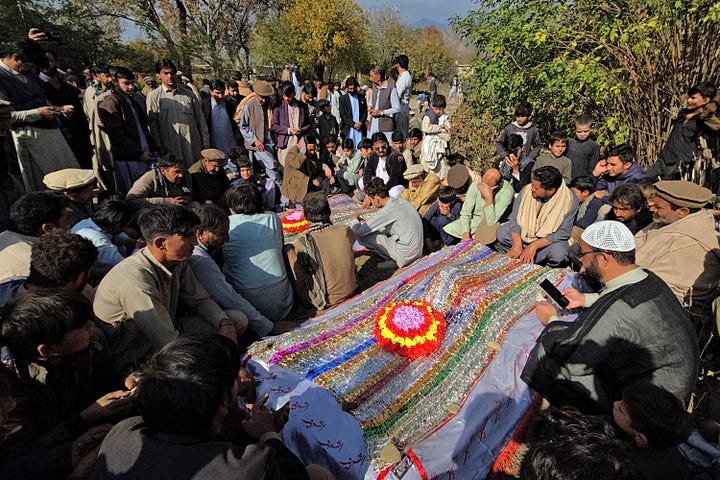
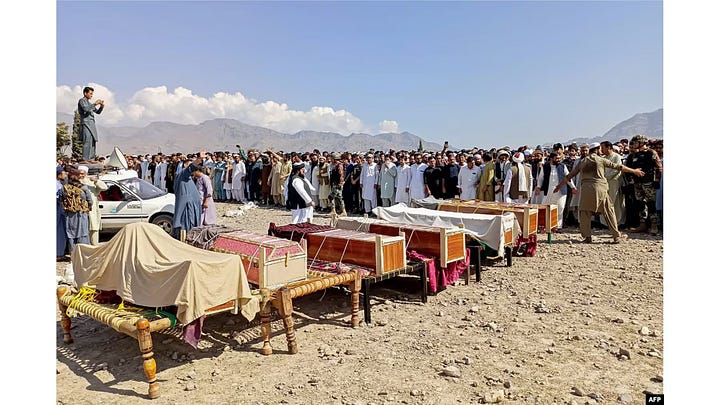

The protracted conflict in Kurram has both local and regional security dimensions. Locally, the fighting manifested as sectarian warfare between Sunni and Shia tribal militias, often organized along village lines. Combatants on both sides built bunkers, took positions in the mountainous terrain, and engaged in ambushes and sniper attacks. The main highway became a battleground: by November, armed groups from each sect were effectively controlling different stretches of the road, preying on travelers from the rival community ('Our Children Are Dying': The Toll of Sectarian Violence in Pakistan’s Parachinar - OneWorld SouthAsia). Checkpoints manned by tribal fighters sprang up, and the state’s writ was severely challenged in these enclaves.
Pakistan’s security forces eventually intervened with targeted operations. In mid-January 2025, after the deadly attack on an aid convoy, the army and Frontier Corps launched a “search and clear” operation in Lower Kurram (areas like Ochat, Charkhel, Dadkamar, and Zeran) (Relief convoy reaches Kurram amid heavy security - Pakistan - DAWN.COM) (Relief convoy reaches Kurram amid heavy security - Pakistan - DAWN.COM). For four days, helicopter gunships and ground troops assaulted militant hideouts. According to officials, they destroyed multiple entrenched bunkers and seized a large cache of weapons (Relief convoy reaches Kurram amid heavy security - Pakistan - DAWN.COM). This show of force was aimed at enforcing the new peace agreement and deterring further convoy attacks. By January 23, 2025, the operation was declared complete, and the military warned that any groups “disrupting peace” would be treated as terrorists (Relief convoy reaches Kurram amid heavy security - Pakistan - DAWN.COM). Troops began patrolling the highway, and special contingents were proposed to permanently secure key routes (Relief convoy reaches Kurram amid heavy security - Pakistan - DAWN.COM). Despite these efforts, security incidents continued sporadically – for instance, on Feb 1, 2025, a convoy of oil tankers was attacked in Kurram (injuring an official), showing that pockets of resistance or banditry still existed (Kurram residents bemoan road closures - Pakistan - DAWN.COM) (Kurram residents bemoan road closures - Pakistan - DAWN.COM).
A crucial element of the peace accord was the disarmament and de-fortification of the area. Both sides agreed to take down private watchposts and bunkers that had proliferated during the clashes ( Kurram secures peace deal: Grand jirga reaches agreement after extended deadlock ). Implementation began in earnest in late January: by early February, authorities reported 22 bunkers demolished in Lower Kurram as part of the accord (Kurram residents bemoan road closures - Pakistan - DAWN.COM). Security forces, along with tribal peace committees, supervised this process. They also set up checkpoints to prevent heavy weaponry from moving into the district. The goal is to “de-weaponise” Kurram so that such sectarian flare-ups are harder to repeat (Relief convoy reaches Kurram amid heavy security - Pakistan - DAWN.COM). However, local sources note that many fighters still possess small arms, and trust-building will take time.
Importantly, the conflict in Parachinar has a broader security context: it was not purely a local tribal feud. Pakistani officials and observers have pointed to the involvement of militant groups like Tehreek-e-Taliban Pakistan (TTP) and the regional offshoot of ISIS (Islamic State Khorasan Province, IS-K). These extremist outfits have reportedly exploited the sectarian rift to gain footholds. Sajid Hussain Turi, a former Member of Parliament from Parachinar, stated that “The Taliban and IS-KP are active in the area,” pressuring local Sunni leaders to keep the clashes going (Taliban, ISIS Fuelled The Sectarian Clashes in Parachinar, Says Ex-MNA - Dissent Today). He noted that TTP and IS militants were present in parts of Lower Kurram up to the Baghgan/Alizai area (Taliban, ISIS Fuelled The Sectarian Clashes in Parachinar, Says Ex-MNA - Dissent Today). Their agenda, he warned, was to fuel chaos and undermine the Shia-majority community. Indeed, the sophistication of some attacks – like the large-scale ambush on the convoy – suggested involvement of well-trained fighters, not just villagers with personal rifles. HRCP also voiced concern that “armed, trained fighters” with heavy weapons had joined the fray, which indicated external backing or infiltration (HRCP calls for urgent action on Kurram crisis - HRCP). These reports align with a general surge of militancy in northwest Pakistan after the Taliban’s return in Afghanistan; Kurram’s turmoil occurred alongside increased TTP violence in adjacent districts (Pakistan: Timeline (Terrorist Activities) - South Asia Terrorism Portal) ( 'Internal matter': Afghan Taliban offer mediation between Pakistan and TTP ).
The presence of these groups has made the security situation more complex. Pakistan’s government has had to consider counterterrorism measures concurrently with tribal reconciliation. In late 2024, the Khyber Pakhtunkhwa (KP) authorities requested federal help to deploy the Frontier Constabulary (FC) – a paramilitary force – to Kurram for restoring order ('Our Children Are Dying': The Toll of Sectarian Violence in Pakistan’s Parachinar - OneWorld SouthAsia). By early 2025, additional police and even “bomb-proof vehicles” were being allocated to secure the region ('Our Children Are Dying': The Toll of Sectarian Violence in Pakistan’s Parachinar - OneWorld SouthAsia). Checkpoints and patrols aim to prevent TTP or IS fighters from regrouping in the area. So far, the military presence has at least stopped large-scale clashes, but locals remain wary. The highway is patrolled, yet travel still often requires military escort. Search operations are intermittently conducted – for example, in February the road was temporarily closed again for a week to allow troops to sweep for any remaining militants in Lower Kurram (Kurram: Tull-Parachinar Road closed for search operations). In summary, while outright warfare has subsided since the January operation, Kurram remains on edge, with a significant security deployment ensuring the siege slowly unwinds without a relapse into violence.
Political Responses from Pakistan and Regional Actors
The crisis in Parachinar elicited significant political attention within Pakistan, though many locals felt the response was slow and inadequate. Federal government: Prime Minister Shehbaz Sharif (who was in office during this period) publicly addressed the situation on multiple occasions. In mid-January, PM Shehbaz told a cabinet meeting that “all stakeholders will maintain peace” and vowed such sectarian violence would “never happen again” (PM Shehbaz vows to maintain peace in district as 25 vehicles of second convoy reach Kurram - DAWN.COM). He lauded the dismantling of bunkers and dispatch of aid convoys, asserting that roads would be reopened and life normalized (PM Shehbaz vows to maintain peace in district as 25 vehicles of second convoy reach Kurram - DAWN.COM) (PM Shehbaz vows to maintain peace in district as 25 vehicles of second convoy reach Kurram - DAWN.COM). Shehbaz also instructed the KP provincial authorities to urgently send medicines and relief to Parachinar ('Our Children Are Dying': The Toll of Sectarian Violence in Pakistan’s Parachinar - OneWorld SouthAsia) ('Our Children Are Dying': The Toll of Sectarian Violence in Pakistan’s Parachinar - OneWorld SouthAsia). Despite these assurances, critics noted that federal action came only after the death toll soared and media spotlight grew. (Pakistan was under a caretaker government for part of this period due to electoral transitions, which may have slowed decision-making.)
At the provincial level, the Khyber Pakhtunkhwa government (led by the interim Chief Minister) took some measures. KP Information Adviser Barrister Muhammad Ali Saif became a point person on Kurram, issuing statements about the crisis. He acknowledged the “shortage of food and medicine” and announced creation of a special police force dedicated to securing the Parachinar road (Over 100 children dead in Parachinar amid road blockades). Under provincial direction, high-level meetings were held to monitor the peace accord’s implementation, including bunker demolition and the arrest of those who “incited hatred” (Relief convoy reaches Kurram amid heavy security - Pakistan - DAWN.COM) (Relief convoy reaches Kurram amid heavy security - Pakistan - DAWN.COM). The KP government formed committees and jirgas to mediate between tribes throughout the conflict. However, some politicians criticized the provincial response as lethargic. Aimal Wali Khan, a senator and president of the Awami National Party (ANP), lambasted the KP authorities for allowing Kurram to be cut off for months. In a late January speech, he called the situation “regrettable as residents even lack edibles, medicines and the right to life”, warning that ANP would protest if the government failed to secure Kurram (Aimal threatens street protests over Kurram crisis - Newspaper - DAWN.COM) (Aimal threatens street protests over Kurram crisis - Newspaper - DAWN.COM). Aimal termed the KP administration “the most incompetent in history” for not preventing the crisis (Aimal threatens street protests over Kurram crisis - Newspaper - DAWN.COM).
Local political leaders in Parachinar were at the forefront of raising alarms. The Majlis Wahdat-e-Muslimeen (MWM) – a Shia political party – organized many protests and press conferences. Agha Muzammil Hussain, an MWM leader and chairman of a local council, led a sit-in and was even arrested briefly for protesting the siege (Another aid convoy reaches Kurram - Pakistan - DAWN.COM). Another MWM representative, Member of National Assembly Haji Hameed Hussain, argued that sending just 40–50 relief trucks was not enough for the population and demanded larger aid convoys (PM Shehbaz vows to maintain peace in district as 25 vehicles of second convoy reach Kurram - DAWN.COM). Meanwhile, Sajid Turi of the Pakistan Peoples Party (PPP) gave interviews highlighting the role of external militants (Taliban/IS) and urging a more robust government strategy (Taliban, ISIS Fuelled The Sectarian Clashes in Parachinar, Says Ex-MNA - Dissent Today) (Taliban, ISIS Fuelled The Sectarian Clashes in Parachinar, Says Ex-MNA - Dissent Today). There was a sense among Parachinar’s Shia leaders that the state needed to crack down on extremist elements in addition to resolving tribal disputes. In response, officials like KP’s Barrister Saif insisted that “militants and extremists on both sides” would be acted against without discrimination (Relief convoy reaches Kurram amid heavy security - Pakistan - DAWN.COM). The provincial police have since registered cases and begun arresting individuals accused of violence (though many ringleaders remain at large).
National political discourse
The Parachinar siege, while a major humanitarian issue, unfolded at a time when Pakistan’s politics were focused on other crises (economic turmoil, a pending general election, etc.). As a result, it did not dominate headlines continuously. However, as news of children dying emerged, more voices from across the spectrum spoke up. Opposition parties (PPP, ANP, JUI-F, etc.) called for protecting the Shia community and restoring law and order. There were also parliamentary discussions; some senators and MNAs pressed the government in Islamabad to explain what was being done to help Kurram. For example, former PM Nawaz Sharif (PML-N) tweeted condolences to victims and urged swift action (though this was largely symbolic). The Human Rights Commission of Pakistan (HRCP) issued a strong statement on November 7, 2024, demanding “urgent attention” to Kurram. HRCP deplored that road blockades and communications blackouts were “periodically cut[ting] off residents’ access to food, fuel and medical supplies”, and it explicitly noted the deaths of sick children and elderly due to lack of care (HRCP calls for urgent action on Kurram crisis - HRCP) (HRCP calls for urgent action on Kurram crisis - HRCP). HRCP called on the state to uphold citizens’ right to life and security, and not to let Kurram’s plight become “the new normal” (HRCP calls for urgent action on Kurram crisis - HRCP).
Regional/International actors
The Parachinar siege was largely an internal Pakistani matter, and direct foreign involvement was limited. That said, the conflict’s sectarian nature drew attention from neighboring Afghanistan and other regional players. The Afghan Taliban government (based in Kabul) offered to mediate between Pakistan and the TTP insurgents as violence spiked. Taliban spokesperson Zabihullah Mujahid in August 2024 described Pakistan’s Taliban issues as an “internal matter” but said “if Pakistan wishes, we can play a mediatory role” ( 'Internal matter': Afghan Taliban offer mediation between Pakistan and TTP ) ( 'Internal matter': Afghan Taliban offer mediation between Pakistan and TTP ). This offer was part of broader Pakistan-TTP dealings and not a direct intervention in Parachinar, but it reflected Kabul’s awareness that Afghan-border areas like Kurram were volatile. No formal international mediation in the tribal dispute occurred; Pakistan relied on its own tribal jirgas and security forces. Iran, a predominantly Shia nation, kept an eye on the situation through its media and religious organizations but stopped short of any official involvement. Iranian media outlets (such as Iran Press and AhlulBayt News Agency) reported on the suffering of Parachinar’s Shia and the solidarity protests in Pakistan’s cities ( Pakistanis Protest Over Parachinar Crises ) (ابنا - Photos: A sit-in protest in solidarity with oppressed Parachinar's Shia continues for seventh night in Lahore). However, the Iranian government did not publicly comment in a diplomatic capacity. Likewise, Western governments and the UN did not issue specific statements on Kurram, likely viewing it through the lens of Pakistan’s domestic sectarian and security challenges. The most notable international response came from rights groups and media (see below) highlighting the humanitarian aspect, rather than direct political intervention by foreign states or bodies.
Humanitarian Organizations’ Statements and Aid Efforts
Throughout the siege, various humanitarian and charitable organizations stepped in to alleviate the suffering, while also pressing authorities to act. One of the earliest and most prominent responders was the Edhi Foundation, Pakistan’s largest charity. In mid-December 2024, as road access was completely cut off, Edhi arranged for a small aircraft to fly medical supplies into Parachinar (Over 100 children dead in Parachinar amid road blockades). A volunteer pilot landed a plane at the Parachinar airstrip on December 17, 2024, carrying boxes of medicines and first aid, as crowds of residents and soldiers gathered to receive the shipment (Over 100 children dead in Parachinar amid road blockades). Edhi ambulances also evacuated a few critically ill patients by air on that occasion ('Our Children Are Dying': The Toll of Sectarian Violence in Pakistan’s Parachinar - OneWorld SouthAsia). Faisal Edhi, the head of the foundation, described conditions in Parachinar as “critical” and urged sustained efforts, noting that their one-time delivery was only a drop in the bucket ('Our Children Are Dying': The Toll of Sectarian Violence in Pakistan’s Parachinar - OneWorld SouthAsia) ('Our Children Are Dying': The Toll of Sectarian Violence in Pakistan’s Parachinar - OneWorld SouthAsia). Indeed, activists pointed out that while Edhi’s help was life-saving for some, “minuscule supplies are not enough for such a large population.” ('Our Children Are Dying': The Toll of Sectarian Violence in Pakistan’s Parachinar - OneWorld SouthAsia) ('Our Children Are Dying': The Toll of Sectarian Violence in Pakistan’s Parachinar - OneWorld SouthAsia) Edhi’s intervention had symbolic importance: it drew national attention to the humanitarian crisis and shamed officials into accelerating their relief plans.
(Over 100 children dead in Parachinar amid road blockades) Volunteers from Edhi Foundation and army personnel unload emergency medical supplies from a small plane at Parachinar’s airstrip, mid-December 2024 (Over 100 children dead in Parachinar amid road blockades). Aside from Edhi, other welfare groups and NGOs mobilized as the siege wore on. The Pakistan Red Crescent Society (the local affiliate of Red Cross/Crescent) contributed to relief convoys once partial access was restored (Taliban, ISIS Fuelled The Sectarian Clashes in Parachinar, Says Ex-MNA - Dissent Today). According to reports, the provincial governments of Sindh and Balochistan also donated food and medicine for the first convoy that was sent after the December peace deal (Taliban, ISIS Fuelled The Sectarian Clashes in Parachinar, Says Ex-MNA - Dissent Today). This inter-provincial aid was coordinated with the Parachinar Trade Union, which took a lead role in organizing truck convoys to bring essentials up the blocked road (Taliban, ISIS Fuelled The Sectarian Clashes in Parachinar, Says Ex-MNA - Dissent Today). The Parachinar Trade Union effectively acted as a humanitarian organizer, gathering supplies and lobbying the government for security escorts. Its president, Haji Nazir Ahmed, continuously updated media on the status of convoys (for example, noting when trucks were stalled or sent back due to danger) (PM Shehbaz vows to maintain peace in district as 25 vehicles of second convoy reach Kurram - DAWN.COM).
Several Shia community organizations and imambargahs (religious trusts) in Pakistan’s big cities collected donations of food, blankets, and medicines for Parachinar. However, with roads closed, delivering this aid was a challenge. In some instances, the Pakistan Army used helicopters to deliver limited supplies. The KP administration confirmed that essential items were being flown via helicopter when possible (Another aid convoy reaches Kurram - Pakistan - DAWN.COM). These air sorties were few, as aircraft availability was limited and weather often poor in winter. Locals frequently complained that government relief was “too little, too late.” By January, helicopter flights from Parachinar to Peshawar were infrequent and could evacuate only a handful of people, doing little to resolve wider shortages (Kurram residents bemoan road closures - Pakistan - DAWN.COM).
Humanitarian advocacy organizations also made their voice heard. As mentioned, the HRCP labeled it a humanitarian crisis and called for urgent action (HRCP calls for urgent action on Kurram crisis - HRCP). International NGOs and the UN did not mount a dedicated relief operation (given Pakistan’s internal capacity and sensitivities), but bodies like UN OCHA monitored the situation. OCHA’s daily updates in late 2024 noted the “3-month long conflict in Kurram District” leading to humanitarian needs, implicitly urging support (e.g., via a 22 January 2025 ECHO Flash update). Moreover, the World Health Organization (WHO) raised concern that the health blockade was causing preventable deaths – local media quoted WHO officials warning that the 80+ day siege was putting thousands of lives at risk (this was echoed in Pakistani health circles, though a formal WHO public statement is not clearly documented).
Religious humanitarian groups were particularly active due to the sectarian aspect. The Shia Ulema Council and Majlis Wahdat-e-Muslimeen not only protested but also set up donation camps for Parachinar. In Quetta and Karachi, Shia volunteers gathered truckloads of flour and rice for their brethren up north. Conversely, some Sunni charities (e.g., Al-Khidmat Foundation run by Jamaat-e-Islami) also extended help to all affected in Kurram, sending a message of harmony. These efforts showed a cross-sectarian empathy from ordinary people, even as militants tried to pit communities against each other.
In summary, humanitarian organizations played a dual role: providing relief and bearing witness. They delivered what aid they could, and they sounded the alarm about the unfolding tragedy. Their interventions, from Edhi’s plane to Red Crescent convoys, alleviated suffering for some and kept the humanitarian imperative in focus even when political will faltered. Yet, given the scale of the blockade, these efforts were far from sufficient to meet all needs. As one doctor observed in December, external aid was just a “lifeline” keeping Parachinar afloat, and that “we are bracing for a wave of deaths” unless the siege ends and normal supply lines resume ('Our Children Are Dying': The Toll of Sectarian Violence in Pakistan’s Parachinar - OneWorld SouthAsia).
Media Coverage and Public Perception
The Parachinar siege gradually gained national and international media attention, though locals often felt their plight was underreported initially. Pakistani media outlets began covering the story more prominently after the November 21 convoy massacre. Television news and newspapers highlighted the sectarian clashes and humanitarian fallout. For example, major dailies like Dawn and The News ran headlines such as “Sectarian violence claims 130 lives in Kurram” (Sectarian violence has killed at least 130 people in Pakistan's ...). Reporters on the ground provided harrowing details: Dawn’s correspondent in Kurram, Javid Hussain, wrote multiple pieces describing how the road blockade led to children dying for lack of oxygen and medicine (Parachinar Siege: 29 Children Dead As City's Only Govt Hospital Faces Shortage Of Medical Supplies - Dissent Today) (Parachinar Siege: 29 Children Dead As City's Only Govt Hospital Faces Shortage Of Medical Supplies - Dissent Today). These reports put a human face on the crisis and were accompanied by images of distraught families. Some media went further, explicitly using the term “siege” – for instance, Dissent Today, an independent outlet, ran a feature titled “Parachinar Siege: 29 Children Dead as City’s Only Govt Hospital Faces Shortage of Medical Supplies.” (Parachinar Siege: 29 Children Dead As City's Only Govt Hospital Faces Shortage Of Medical Supplies - Dissent Today) (Parachinar Siege: 29 Children Dead As City's Only Govt Hospital Faces Shortage Of Medical Supplies - Dissent Today) Published on Dec 20, 2024, that story was one of the first to extensively document the healthcare collapse in Parachinar and helped galvanize public empathy.
By late December, the Pakistani press widely recognized the humanitarian crisis in Parachinar. The Guardian (UK) also picked up the story around Nov 23, noting that hundreds were fleeing “deadly sectarian violence” in northwest Pakistan (the Guardian cited HRCP’s warnings and called it a humanitarian emergency). The international media otherwise gave moderate coverage: wire services like AP and AFP released reports when death tolls spiked, and outlets in neighboring countries (e.g. The Hindu in India (Over 100 children die in Pakistan's Parachinar amid ongoing road ...)) reported that “over 100 children” had died due to the siege. Al Jazeera and VOA (Voice of America) filed analyses on the sectarian dimensions, explaining the history of Parachinar’s conflicts and the role of militants (Why is Parachinar Stuck in an Endless Loop of Violence? – South Asian Voices) (Sectarian violence in Pakistan border district claims more than 130 lives). Such coverage sometimes linked the Parachinar clashes to the broader resurgence of the Pakistani Taliban post-2021. On social media, Pakistani netizens used hashtags like #ParachinarSiege and #KurramCrisis to share news and demand action. However, misinformation also spread online, prompting community leaders to urge caution – the peace jirga in February even decried the “misuse of social media” to inflame tensions (Kurram residents bemoan road closures - Pakistan - DAWN.COM).
Public perception within Pakistan: Among the general public, especially the Shia community, there was an outpouring of solidarity with Parachinar. As the news of starving children came out, civil society groups organized protests across multiple cities. On December 28, 2024, countrywide protests and rallies were held after Friday prayers in major cities – including Islamabad, Lahore, Karachi, Peshawar, Quetta, and even Parachinar itself ( Pakistanis Protest Over Parachinar Crises ) ( Pakistanis Protest Over Parachinar Crises ). These demonstrations were largely led by Shia organizations (like MWM and Shia Ulama Council), but many Sunni allies and human rights activists joined in, condemning “terrorism and road closures” in Parachinar ( Pakistanis Protest Over Parachinar Crises ). Protesters carried placards with slogans such as “Stop the bloodshed in Kurram” and “Open the roads – our children are dying” ( Pakistanis Protest Over Parachinar Crises ). In Lahore, a sit-in was staged in front of the Press Club for several consecutive nights in late December, coinciding with the end of Arbaeen (a Shia mourning period), to draw attention to Parachinar (Photos: A sit-in protest in solidarity with oppressed Parachinar's Shia ...) (ابنا - Photos: A sit-in protest in solidarity with oppressed Parachinar's Shia continues for seventh night in Lahore). This Lahore sit-in lasted at least seven nights through New Year’s Eve, with participants lighting candles and reading out the names of children who had died due to the blockade (ابنا - Photos: A sit-in protest in solidarity with oppressed Parachinar's Shia continues for seventh night in Lahore). The public outcry from these events put pressure on authorities; speakers at the rallies warned that if the government didn’t act, nationwide sit-ins would continue ( Pakistanis Protest Over Parachinar Crises ).
Within Kurram itself, public sentiment was mixed with fear and hope. On one hand, people from both sects welcomed the December 31 peace agreement, hoping it would end the violence (Parachinar sit-in continues despite peace deal - Pakistan - DAWN.COM). On the other hand, Parachinar’s residents remained deeply frustrated that it took so long to address their isolation. For months, they had been holding a sit-in at the Parachinar Press Club (the heart of the city) pleading for help. Even after the peace deal, on January 3, 2025 protesters in Parachinar announced they would not end their sit-in until the roads were truly open and safe (Parachinar sit-in continues despite peace deal - Pakistan - DAWN.COM). Local media covered this extensively: headlines like “Parachinar sit-in continues despite peace deal” (Parachinar sit-in continues despite peace deal - Pakistan - DAWN.COM) underscored the public’s distrust, born of previous broken truces. Protesters emphasized that “normalcy” meant more than a signed agreement – it meant being able to travel without risking one’s life (Parachinar sit-in continues despite peace deal - Pakistan - DAWN.COM).
The broader Pakistani public, once informed, largely sympathized with Parachinar’s plight. There was notable support on social media from people of all sects calling for unity and urging the government to “save Parachinar.” However, there were also segments of society influenced by sectarian narratives who viewed the conflict through a biased lens. Hardline Sunni and Shia commentators traded barbs, with each side accusing the other of aggression. Such rhetoric occasionally spilled into mainstream media discussions. The peace jirga’s call to rein in social media propaganda was an acknowledgement that online flames needed to be doused to prevent reigniting violence (Kurram residents bemoan road closures - Pakistan - DAWN.COM).
In summary, media coverage turned Parachinar from a neglected frontier issue into a national concern by late 2024. Public perception shifted from ignorance to empathy and outrage, pushing officials to expedite relief. The situation was increasingly framed not just as law-and-order failure, but as a humanitarian catastrophe that violated citizens’ rights. This framing helped build public support for strong government intervention to end the siege. By early 2025, “Parachinar” had become a rallying cry in Pakistan for protecting vulnerable communities from sectarian terror, much as it had after past tragedies (Parachinar also saw devastating bomb attacks in 2007 and 2017, so it’s a familiar name associated with resilience and suffering).
Diplomatic Negotiations and Efforts Toward Resolution
Resolving the Parachinar siege required careful negotiation and confidence-building between the hostile factions. Traditional conflict-resolution mechanisms played a central role – notably the convening of tribal jirgas (councils) comprising elders and notable figures from Kurram. These jirgas acted as mediators to broker ceasefires and the eventual peace agreement. The process unfolded in stages:
Local Ceasefires: Early in the conflict, tribal elders from both Shia and Sunni communities met to halt fighting. One significant ceasefire was reached in October 2024, when elders intervened after an eruption of clashes (this came after the September violence) (HRCP calls for urgent action on Kurram crisis - HRCP). However, such truces were fragile and often collapsed with the next provocation. On November 23, 2024, as mentioned, a week-long ceasefire was arranged by a government-backed committee right after the convoy massacre. This pause allowed the exchange of some captives/hostages held by each side during the chaos (Sectarian violence in Pakistan border district claims more than 130 lives). It also facilitated evacuation of some injured. Yet the November 23 ceasefire was broken within days, demonstrating the need for a more comprehensive settlement.
Grand Jirga and Peace Deal: In December 2024, as the humanitarian situation worsened, authorities escalated diplomatic efforts. A Grand Jirga was formed, including not just local elders but also lawmakers, senators, and influentials from the wider region. This jirga held a series of marathon meetings in Kohat (a neutral location) over three weeks ( Kurram secures peace deal: Grand jirga reaches agreement after extended deadlock ) ( Kurram secures peace deal: Grand jirga reaches agreement after extended deadlock ). Key figures like the Commissioner of Kohat Division oversaw the talks ( Kurram secures peace deal: Grand jirga reaches agreement after extended deadlock ). On December 31, the jirga succeeded in getting representatives of the warring Turi (Shia) and Bangash (Sunni) tribes to sign a written peace agreement ( Kurram secures peace deal: Grand jirga reaches agreement after extended deadlock ). According to this accord: (a) both sides agreed to surrender their heavy weapons and demolish their bunkers ( Kurram secures peace deal: Grand jirga reaches agreement after extended deadlock ); (b) they pledged to desist from attacking each other and to resolve future disputes through dialogue; (c) the government, for its part, agreed to reopen access routes to Kurram once security was assured ( Kurram secures peace deal: Grand jirga reaches agreement after extended deadlock ) and to form a special 399-member force to guard the roads ( Kurram secures peace deal: Grand jirga reaches agreement after extended deadlock ). The formal announcement of the Kurram Peace Agreement was made at the Governor House in Peshawar, indicating high-level endorsement ( Kurram secures peace deal: Grand jirga reaches agreement after extended deadlock ). Notably, enforcement mechanisms were included: an apex committee (involving civil and military officials) would monitor compliance, and any violations could be dealt with under anti-terror laws.
Post-agreement Negotiations: Even after the accord, dialogue continued to address implementation details. In early January 2025, the two sides and jirga members met again in Islamabad to iron out issues such as opening roads and removing remaining irritants (Kurram residents bemoan road closures - Pakistan - DAWN.COM) (Kurram residents bemoan road closures - Pakistan - DAWN.COM). These talks were relatively cordial and focused on practical steps. Both tribal leaders – one Shia, one Sunni – jointly emphasized stopping inflammatory rhetoric on social media and ensuring peace committees work effectively (Kurram residents bemoan road closures - Pakistan - DAWN.COM). The absence of government representatives in some follow-up meetings (as noted on Feb 3 (Kurram residents bemoan road closures - Pakistan - DAWN.COM)) suggests the communities were taking ownership of reconciliation, which can be a positive sign for durability of peace.
Role of Government and Security Forces: Alongside tribal negotiations, the Pakistani state applied pressure and incentives. The military operations in January (discussed earlier) were one form of pressure – by dislodging hardliners who opposed peace, the army strengthened the moderate elders’ position at the table. On the incentive side, as soon as the Dec 31 deal was signed, authorities arranged the first relief convoys to Kurram as a goodwill gesture. The Parachinar Trade Union coordinated with the district administration to send a convoy of 40 trucks laden with food on January 5, 2025 (PM Shehbaz vows to maintain peace in district as 25 vehicles of second convoy reach Kurram - DAWN.COM). Though that convoy was delayed for days in the garrison town of Thall (due to security concerns), it eventually proceeded under escort (PM Shehbaz vows to maintain peace in district as 25 vehicles of second convoy reach Kurram - DAWN.COM). Similarly, the second convoy (45 trucks) was dispatched by January 14 (PM Shehbaz vows to maintain peace in district as 25 vehicles of second convoy reach Kurram - DAWN.COM) (PM Shehbaz vows to maintain peace in district as 25 vehicles of second convoy reach Kurram - DAWN.COM). The successful arrival of these convoys was both a humanitarian relief and a confidence-building measure signaling that the peace pact had tangible benefits. Each convoy that got through without incident built trust. By late January, at least five convoys had reached Parachinar under army and police protection (Another aid convoy reaches Kurram - Pakistan - DAWN.COM) (Another aid convoy reaches Kurram - Pakistan - DAWN.COM). This incremental reopening of the road network was effectively part of the negotiation process – militants saw their leverage wane as the siege was broken, and locals saw reason to uphold peace as supplies came in.
(PM Shehbaz vows to maintain peace in district as 25 vehicles of second convoy reach Kurram - DAWN.COM) Heavily guarded aid convoys, like this one of food trucks, became the lifeline for Parachinar once a ceasefire allowed sporadic road access in Jan 2025 (Another aid convoy reaches Kurram - Pakistan - DAWN.COM) (Another aid convoy reaches Kurram - Pakistan - DAWN.COM). The ultimate goal of negotiations – a full restoration of normalcy – is still a work in progress. As of February 27, 2025, diplomatic efforts (in the broad sense of tribal diplomacy and state facilitation) continue to ensure the agreement holds. Tribal elders from both sects are reportedly patrolling jointly in some areas to prevent miscreants from sabotaging the peace. The district administration is working on a plan to compensate those who lost homes and shops (a key demand from the Sunni side after Baghgan bazaar was destroyed) (Another aid convoy reaches Kurram - Pakistan - DAWN.COM). Another ongoing discussion point is the opening of alternative routes: locals have urged opening the Kharlachi border crossing to Afghanistan to allow supplies if the domestic route is shut (Another aid convoy reaches Kurram - Pakistan - DAWN.COM). While not a direct negotiation between combatants, it involves diplomatic coordination with Afghan authorities. There is also talk of a truth and reconciliation commission of sorts, to address grievances and prevent revenge cycles – though this is in early stages.
In terms of formal diplomacy, since both warring parties are Pakistani citizens, the resolution has been an internal affair mediated by local customs. The success of the Grand Jirga approach in ending the major violence underscores the value of indigenous conflict resolution in the tribal context. However, lasting peace will likely require continued engagement and monitoring. Both the military and jirga mediators have pledged to stay vigilant for at least six months to a year, ready to intervene at the first sign of trouble. International diplomatic involvement has been minimal, limited to Afghan Taliban’s offer to mediate with the TTP as noted (which Pakistan has not taken up, preferring to handle TTP its own way). If the situation had deteriorated further, one could have imagined UN or OIC (Organization of Islamic Cooperation) appeals for calm, but fortunately the local efforts yielded a peace deal before that was necessary.
Current status (Feb 27, 2025): Diplomatically, the situation is in a phase of monitoring and implementation. The peace agreement from Dec 31 is the framework, and thus far both tribes have publicly stuck to it – there have been no large-scale breaches since the January convoy attack incident was addressed. Negotiators meet periodically to discuss outstanding issues (like full road reopening and return of displaced families). The tone of these meetings has reportedly been constructive, indicating that war fatigue and the horrors witnessed have instilled a genuine desire for peace on all sides (Kurram residents bemoan road closures - Pakistan - DAWN.COM) (Kurram residents bemoan road closures - Pakistan - DAWN.COM). As one jirga member put it, “the people of both sides were facing difficulties due to the unrest, which needs to be resolved immediately.” (Kurram residents bemoan road closures - Pakistan - DAWN.COM) This shared sentiment bodes well for continued reconciliation.
It is important to note that Parachinar’s “siege” will truly be over only when everyday citizens can travel freely and commerce resumes normally. Diplomatic and peace efforts are squarely focused on that objective now. There is cautious optimism among observers that with spring approaching and dialogue ongoing, 2025 will not see a repeat of the bloodshed of 2024 in Kurram. The situation remains fragile but markedly improved, shifting from open conflict to a difficult recovery phase.
Sources: Recent news reports, eyewitness accounts, and official statements have been used to compile this report. Key references include reporting by Dawn, Dissent Today, Geo News, the Human Rights Commission of Pakistan,Voice of America, South Asian Voices, and Express Tribune, among others.



